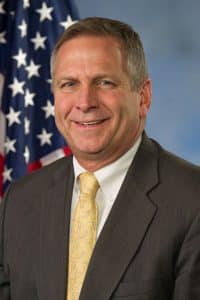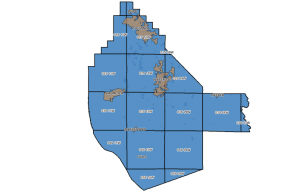Bost talks infrastructure, redistricting

With his congressional district boundaries changing and recent passage of President Joe Biden’s $1.2 trillion infrastructure plan into law, U.S. Rep. Mike Bost (R-Murphysboro) is weighing in on these trending topics.
Infrastructure act
Last week began with the Infrastructure Investment and Jobs Act, HR 3684, officially becoming public law.
The majority of the act’s investment breakdown, according to jdsupra.com, is allocated toward highways, roads, bridges and other transportation-related improvements. The site said $110 billion is set aside for roads and bridges specifically.
According to a White House fact sheet titled “The Infrastructure Investment and Jobs Act will Deliver for Illinois,” Illinois is expected to receive $9.8 billion for federal highways, the largest funding category for the state, and $1.4 billion for bridges. This is over a five-year time frame.
The document states Illinoisians can also expect to see approximately $4 billion to improve public transportation, $149 million to expand the state’s electric vehicle charging network, and $616 million for airport improvements and more, all over five years.
A minimum of $100 million will be directed toward expanding broadband coverage.
Bost said one of the main reasons why he did not vote in favor of the act is because a small percentage of the $1.2 trillion actually goes to what is typically considered infrastructure, such as bridges, roads, waterways, airports, railroads, waterlines and sewer lines and internet.
“About 28 percent of the bill actually goes toward those things,” Bost said. “If your question is, ‘Will there be help in there?’ Yes, there will. But, when you’re talking about ($1.2 trillion) and only 28 percent goes to those things … and the taxation doesn’t really line up with being able to generate the revenues necessary, that is the problem.”
Bost said the bill was often championed as it projected an approximate 32 percent return on investment. He said he does not foresee this happening.
“The problem also with the bill is the bill is based on a 32 percent return on investment,” he said. “Talk to any investment person (and they’ll tell you) you don’t get 32 percent on anything, but yet they use their calculations to say ‘We’re going to be able to generate enough revenue because we’re going to get 32 percent back. That won’t work. It doesn’t calculate out that way.”
He pointed to protecting against natural disasters as one example of how the act’s name is deceiving.
According to the fact sheet, “Illinois will expect to receive $27 million over five years to protect against wildfires and $22 million to protect against cyberattacks.”
For Bost, many portions of the act, such as the provision for more EV stations, are trying to move forward climate-friendly economic policy “when we don’t have the technology yet to implement the Green New Deal.”
In the fact sheet, the White House said Illinois would receive approximately $149 million over five years to expand the number of EV chargers, which is subject to change based on updates to fiscal year data. The sheet also notes the bill provides $2.5 billion in grant funding for this cause that the state may apply for.
Bost said even though electric cars make up just 2 percent of vehicles driven in the U.S., the private sector is already providing charging stations at airports, truck stops and other locations.
“The thing is, how do you think we’re going to generate the electricity to charge them? People with the power grid right now will tell you that we’re not ready for that,” Bost said. “But if you wanted the free market to work, the free market was already working … all of a sudden, the government says, ‘No, we’re going to put those in place? Well, why? Because the market was doing it, you could go and charge your vehicle, and the market knew it was there, and it was growing at the same rate it was. But instead they took your tax dollars, a lot of your tax dollars, and a lot of our children and grandchildren and great-grandchildren’s tax dollars, borrowed money, and now all of a sudden want to build this grid when they could have went ahead and made it all in the (typical) infrastructure areas I was talking about.”
Even though the act is now officially law, Bost said this does not mean Monroe County will see immediate movement on related projects. He explained each respective federal department must finalize language before funding can be distributed to individual states.
For example, for bridges, roads and the like, this federal entity is the Department of Transportation. He expects this process to be consistent with how similar money has been distributed in the past.
“Each line item that is placed in there still has to go through the process through the Department of Transportation to figure out which area it goes into and then they will write the language that allows the states to apply, and then the states apply, and then the cities and local governments apply through their states like they do for any other infrastructure bill,” Bost said.
Once this occurs, some projects may move faster than others. He said these are commonly referred to as “shovel ready” projects such as locks, dams and levee systems; roads; bridges and highway expansions.
Others may prove to be more of a challenge, such as getting rid of the “digital divide” by expanding high-speed internet to rural areas.
“Inner cities might be a little bit easier and be able to roll out faster, (but) the rural areas are more difficult because you’ve got to actually have the engineers come out, calculate where they need to put these systems, how they wire the system. You’re talking about a lot of ditch digging and laying lines,” Bost explained.
Redistricting
With final approval of the new state congressional redistricting plan earlier this month, Illinois now has 17 districts instead of 18 due to population loss.
However, as Bost explained, each district now has 760,000 people.
With this redistricting, Bost lost a lot of heavily-populated communities – such as what he had of Madison County and a large share of St. Clair County – but he gained a broader territory in order to ensure he met the 760,000 mark.
Bost said he previously represented 12 counties, but now has “all or part of 34 counties.” The majority of this consists of small towns and farmland.
“I say it like this to people: I received all of those other counties, and the majority of those have a lot more deer population than humans,” he said.
Bost said representing this broad of a landscape will require him and his staff to rethink their office locations and increase their time spent traveling. He said his district office will probably be moving to the Mt. Vernon area and he will most likely keep the Carbondale office.
Bost also plans to implement approximately six rotating regional satellite offices, where close counties will be grouped together and a staffer will work from one of their courthouses once a week.
While covering such a large area may seem like a challenge, Bost said he is confident he can meet his population’s needs.
“We will reach out and make sure that, and I’ve always done this anyway, all of my mayors and all of my county chairmen of the county boards and all of that have our contact information so that they know that they can quickly get ahold of us if there’s a need or whatever that might be, and then we make sure that our constituents know how to get ahold of us as well,” he said, pointing out that some of his colleges represent entire states.






